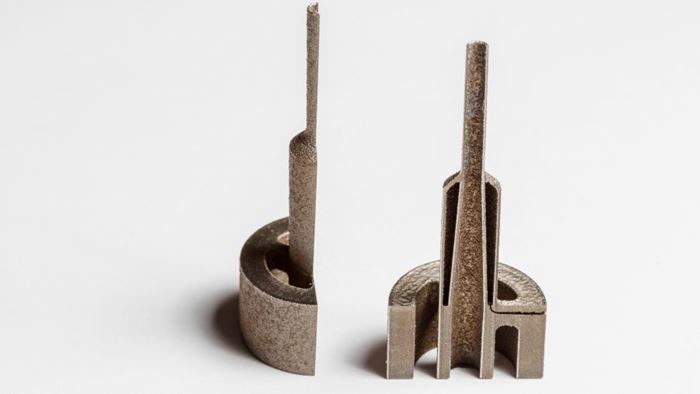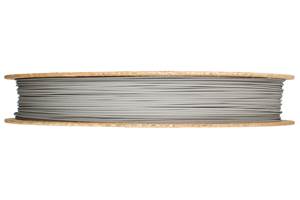Co-Extrusion Nozzle Made in One Piece with Selective Laser Melting
Selective laser melting enabled a complex nozzle assembly to be made in one piece, demonstrating speed and cost savings for the low volumes required.
Share
Read Next
A good design does not always mean a complex geometry, but as parts become more customized to their task, there may be a point where added intricacy is beneficial. In the case of a specialized nozzle for a major food manufacturer, transitioning from machining to selective laser melting meant a complex, one-piece nozzle design, but also eliminated assembly, reduced setups and improved cost effectiveness for the small batch size required.
The nozzle is intended to extrude two materials simultaneously for a specific food production process. The co-extrusion process also requires thin structures in the nozzle to avoid defects in the final product, meaning that the walls of the nozzle are just 0.4 mm thick and dimensions must be achieved at a tolerance of 0.04 mm. An internal cavity creates a thermal barrier between the two materials before they are brought together, reducing heat transfer that could damage the final product.
The nozzle was previously manufactured with traditional subtractive techniques. The internal cavity was achieved by manufacturing the nozzle in two pieces and then brazing them together. External dimension of the outer part required a tolerance of just 0.03 mm to ensure the vacuum braze would form a good bond.
Both parts of the nozzle were turned from S162D maraging steel, a process that required the complex setup and programming of a CNC machine. The inner nozzle then moved to a wire EDM to have slots cut into it before both parts moved to inspection. After passing inspection, they were heat treated and sent on to be vacuum brazed before the final inspection.
Precision manufacturer Frazer-Nash (based in the United Kingdom) believed that the nozzle could be more efficiently and cost-effectively produced with metal additive manufacturing. Using a combination of selective laser melting (SLM) technology and precision finishing, the company was able to produce small batches of the nozzles faster and at lower cost.
First, a digital 3D CAD model of the existing nozzle was loaded into Magics, an additive manufacturing preparation system. The design was modified to allow the two-part assembly to be 3D printed as just one piece, eliminating the brazing step and reducing setups. Additional material was added to the design on dimensionally significant surfaces to provide a suitable allowance for the final precision machining.
The new nozzles are built using the Renishaw AM250, a selective laser melting (SLM) system capable of producing high-density metal objects. The powder-bed machine uses a laser to trace the shape of each horizontal layer into powder, melting and solidifying it into a solid form.
Once the parts are printed, the support structure at the base is removed using wire EDM. Each part is cleaned ultrasonically to remove remaining metal powder, and then is bead blasted to prepare it for heat treatment prior to inspection.
At this point, the nozzles are close to the required final geometry but with a finish similar to that of a casting. Frazer-Nash uses a lathe to precision finish the rough parts to the required tolerances. Then, they are polished internally and externally for a final finish.
By producing the nozzles at near-net shape with SLM, the time needed for machining is reduced and less material must be removed. Though the one-piece design is more complex, Frazer-Nash was able to reduce the critical tolerances by eliminating the brazing step. Additively manufacturing the nozzle in one piece proved to be quicker and cheaper for the low volumes of parts required.
Related Content
Xenia Creates Lightweight, High-Performing, Sustainable 3DF Filament Materials for Fused Filament Fabrication 3D Printing
Formnext 2024: The filaments’ properties include exceptional strength, lightweight design, chemical resistance and sustainability.
Read MoreMedical Molder Relies on 3D Printing to Speed Development of Inspection Fixtures
Medical molder Medbio uses FFF and SLA 3D printers in designing (and sometimes producing) its inspection fixtures.
Read MoreRaise3D’s Hyper Core Filament Line Offers Increased Heat Conductivity for Rapid Melting and Cooling
Raise3D has also launched its Pro3 HS Series which enables higher speed printing with composite materials to meet demanding engineering and manufacturing needs. The series includes the Pro3 HS, Pro3 HS Plus, Pro3 + HUK3 and Pro3 Plus + HUK3.
Read MoreVirtual Foundry’s M300 Tool Steel Filamet Offers Strength, Versatility for FFF 3D Printing
The Virtual Foundry developed its M300 Tool Steel Filamet material for fused filament fabrication, offering compatibility with a variety of 3D printers.
Read MoreRead Next
Bike Manufacturer Uses Additive Manufacturing to Create Lighter, More Complex, Customized Parts
Titanium bike frame manufacturer Hanglun Technology mixes precision casting with 3D printing to create bikes that offer increased speed and reduced turbulence during long-distance rides, offering a smoother, faster and more efficient cycling experience.
Read MoreProfilometry-Based Indentation Plastometry (PIP) as an Alternative to Standard Tensile Testing
UK-based Plastometrex offers a benchtop testing device utilizing PIP to quickly and easily analyze the yield strength, tensile strength and uniform elongation of samples and even printed parts. The solution is particularly useful for additive manufacturing.
Read MoreAlquist 3D Looks Toward a Carbon-Sequestering Future with 3D Printed Infrastructure
The Colorado startup aims to reduce the carbon footprint of new buildings, homes and city infrastructure with robotic 3D printing and a specialized geopolymer material.
Read More
.jpg;width=70;height=70;mode=crop)






















